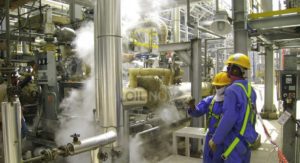The Guyana government approved two projects in 2022, that represent major milestones in the small South American nation’s mission to become a developed nation – Yellowtail and Gas-to-Energy. Both projects feature the involvement of oil major ExxonMobil and its Stabroek Block partners, Hess and CNOOC.
Yellowtail Oil Development
The Ministry of Natural Resources and the Environmental Protection Agency (EPA) announced April 1 that they have decided to greenlight ExxonMobil’s Yellowtail project.
ExxonMobil plans to place a floating production, storage, and offloading (FPSO) vessel, called ONE GUYANA, offshore Guyana to develop more than 900 million barrels of oil.

Yellowtail is the fourth development being pursued by the oil major offshore Guyana but stands out in multiple ways. Its oil production capacity of 250,000 barrels per day (bpd) will exceed that of all the projects before it. And it is one of the largest projects of its kind in the world. But most of all, the US$10 billion Yellowtail project will make Guyana the world’s largest per capita producer of oil, according to Energy Co-Director at Americas Market Intelligence (AMI), Arthur Deakin. Yellowtail’s 250,000 bpd will add to the 140,000 bpd from Liza Phase 1, 220,000 bpd from Phase 2, and 220,000 bpd from Payara, ramping up total capacity to approximately 830,000 bpd.
Yellowtail is expected to achieve first oil just 10 years after the first discovery in 2025.
Guyana is pursuing this development trajectory, even in the face of criticisms from environmental activists at home and abroad, that increased oil production would be catastrophic for the environment. Officials maintain that the carbon sequestration provided by the country’s large forest endowment allows the country to remain a carbon sink even with its aggressive oil production plans. The government also plans to use the revenues from oil to adapt and mitigate against the changing climate.
Gas-to-Energy Project
This is the first project that will tap into Guyana’s 16 trillion cubic feet of natural gas reserves. The EPA announced approval for Gas-to-Energy (GTE) at the end of November.
It involves the laying of a pipeline that will transport 50 million cubic feet per day of gas from ExxonMobil’s Liza field to a facility at Wales on the West Bank of the Demerara River. The onshore facility will comprise a natural gas liquids (NGL) facility and a power plant. The responsibility for developing various aspects of the project is shared between the government and ExxonMobil.
Expected to cost more than US$2 billion, GTE is expected to be the most transformative project in Guyana’s history. Guyana has been long known for having electricity rates among the highest in the region, based on imports of heavy fuel oil (HFO). This project will switch out HFOs with the less polluting natural gas and provide the government the fiscal space to slash power costs by 50%. Such a project has the potential to return considerably more disposable income into families’ pockets and improve businesses’ profit margins. It would also make Guyana a more attractive investment destination.
In addition to cutting the cost of power, the government said it will open an industrial estate at the site of the onshore plants, for business ventures to make use of the NGLs. Government has already said it intends to offer cooking gas (liquefied petroleum gas) at reduced prices when the project comes on stream.
The pipeline and power plant are expected to be completed at the end of 2024, and the NGL plant in the following year.
Government has faced criticism for embarking on this fossil-fuel project, which is expected to last for more than two decades. The administration believes the project will have a positive effect on Guyana’s emissions, once the switch to natural gas is made from HFOs. The government has also said that the project will kickstart its energy transition agenda.




